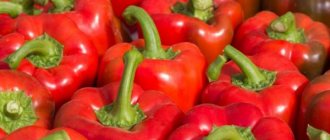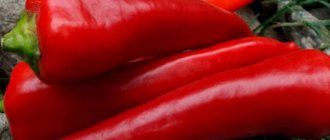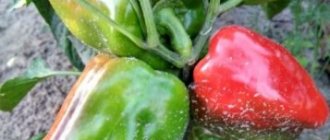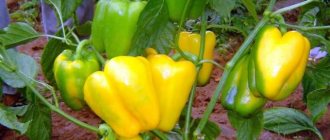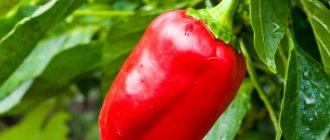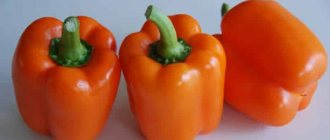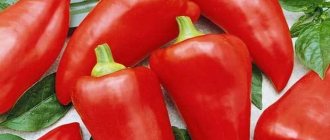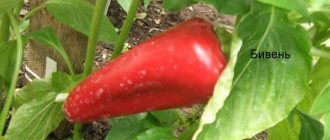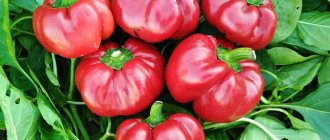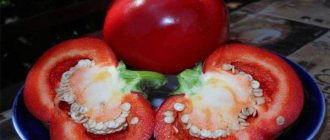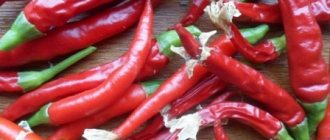Sweet peppers are called a storehouse of vitamins. This crop is not as popular among gardeners as, say, tomatoes, since it is much more heat-loving. For example, in the northern regions, pepper can be grown exclusively in greenhouses; special varieties have been created for this. One of the most famous is the Health pepper.
- 2 Description of the pepper variety Health
- 3 Characteristics of the pepper variety Health
3.1 Video: pepper seeds Health
History of growing the pepper variety Zdorovye
Pepper Zdorovye has been known for a long time; it was included in the State Register of Breeding Achievements of the Russian Federation in 1986, however, there is no detailed description of the variety in the official document. The variety is a development of the All-Russian Research Institute for Selection and Seed Production of Vegetable Crops (VNIISSOK), based in the Moscow region. Recommended for planting in greenhouses in the Northern and North-Western regions. In these parts, it is unrealistic to grow sweet peppers in open ground, and not every variety of this capricious vegetable crop does well in greenhouses.
In addition to the recommended regions, Zdorovye pepper is successfully grown in other areas with cool climates: in the Urals, Siberia and even in the middle zone. This is due to its good consumer properties and relatively simple agricultural technology. In the southern regions, this variety is also planted in unprotected soil; However, in recent years many varieties have appeared that are more suitable for this purpose.
Advantages and disadvantages
The benefits of the Health pepper variety outweigh its disadvantages. He earned a positive rating for the following qualities:
- this variety produces a stable harvest;
- has good fruit set in low light;
- is universal in use, suitable for canning whole fruits;
- the variety is resistant to blossom end rot and various diseases;
- It is distinguished by early ripening and manages to ripen even in the Ural region.
The disadvantages include the significant height of the bushes, due to which they need to be tied up.
Description of the pepper variety Health
Pepper in general is a difficult crop to grow, which is also due to the long growing season. Therefore, early ripening varieties, which include Zdorovye pepper, are especially valued. This crop is especially difficult to succeed in those regions where the summer is short and even in greenhouses the daylight hours are insufficient for the full development of the bush and the ripening of fruits. The Health variety tolerates insufficient lighting, so in northern greenhouse conditions it grows and bears fruit normally. It is often even classified as ultra-early, since the first fruits can be harvested approximately 80 days after germination: there are very few such varieties. True, it takes another 3–4 weeks to achieve biological ripeness, but even in the green state, the peppers are quite tasty and have already collected a sufficient amount of vitamins.
Peppers are often grown in greenhouses; Tall varieties are especially interesting for this purpose
It is especially important to be able to grow sweet (Bulgarian) peppers in the northern regions, since this crop has a wide range of vitamins: ascorbic acid in it is approximately the same as in black currants, and vitamin A - as in carrots. In this regard, the Zdorovye variety fully fits into the strategy for improving the health of the population, which suffers from a lack of natural vitamins due to the difficulty of growing fruits and vegetables. The variety got its name for a reason; it is associated with the unique chemical composition of the fruit.
The Zdorovye pepper bush is semi-spreading and differs from many varieties in its considerable height, which can reach one and a half meters or more. In this regard, when growing it, there is a need for tying, and preferably not to stakes, but to a trellis, so that the shoots with fruits are more evenly distributed in space and better illuminated.
Tall varieties of any vegetables are especially advantageous for greenhouse cultivation, where every centimeter of not only space, but also useful volume is valuable.
The overall yield of the Zdorovye variety is not bad and can be up to 5 kg/m2. The bushes are strewn with fruits, but peppers have light fruits, and the external impression of a huge harvest never translates into enormous numbers. The fruits themselves are relatively small, prism-shaped, elongated, with a not entirely smooth surface, and droop down when placed on the bushes. Outwardly, they resemble the fruits of most spicy varieties, but appearances are deceiving. When the fruits reach technical ripeness and are already quite suitable for consumption, they have a light green color. Subsequently, through the yellow stage, they become red. At this moment, their seeds are already ripening, which can be used for sowing next year.
The bushes are strewn with fruits, while they contain both still green and completely ripe peppers
The fruits are juicy, quite fleshy, but the wall thickness is small, just over 4 mm; in this regard, the Zdorovye variety lags far behind many modern varieties. The skin is thin and cannot be felt when eating. The size of the fruit is modest: no more than 12 cm in length, about 6 cm in diameter. The weight of the fruit is about 40 g. The taste is assessed by various tasters as good or excellent. The variety is universal in purpose: it is suitable both for fresh consumption, which is especially important in the North, and for various types of preparations. If light green fruits can be removed for direct consumption, already reddened fruits are mainly used for harvesting.
Fruit characteristics
The fruits of the Health variety are distinguished by the following characteristics:
- The shape of the peppers is prism-shaped, elongated, the surface is slightly wavy, the fruits droop down. In general, the shape and size of peppers of this variety somewhat resemble representatives of the hot pepper family, so not everyone dares to try them from the bush.
- At the stage of technical maturity, when the fruits can already be eaten, they are characterized by a light green color. Having reached biological maturity, that is, the moment when the seeds in them fully ripen for further sowing, the peppers acquire a red tint.
- The thickness of the walls is not very large - about 4.2 mm, but they themselves are quite fleshy and juicy, the skin is thin and tender.
- The fruits are small in size, reaching 10-12 cm in length, with an average diameter of 5.5 - 6.5 cm. The weight of one pepper usually does not exceed 35-45 g.
- Pepper Zdorovye has good and excellent taste characteristics. When fresh, even at the stage of technical maturity, it is very tasty and does not taste bitter at all. But for twists it is better to wait for biological maturity, since in jars in green form it can change its taste.
Characteristics of the pepper variety Health
The generalized characteristics of the Zdorovye pepper are given in the following table provided by the originator of the variety.
Table - main properties of pepper Health
| Group | variety |
| Peculiarities | capable of producing high-quality fruits in low light conditions (in cloudy weather) |
| Main advantage | friendly harvest formation |
| Maturation | ultra-early ripening |
| Purpose | in cooking and canning |
| Taste qualities | excellent |
| Commercial qualities | high |
| Disease resistance | disease-resistant |
| Sustainability | to apical rot |
| Description of the fruit | |
| Color | green/red |
| Length (cm) | 10 - 12 cm |
| Form | prism-shaped |
| Peculiarities | wall thickness 3 - 4 mm. |
| Weight | 33 - 41 g |
| Features of agricultural technology | |
| Period from germination to technical maturity | 78 - 87 days |
| Growing | indoors |
| Sowing | March |
| Sowing scheme | 50 x 35 cm |
| Sowing depth | 1–3 cm |
| Cleaning period (months) | June |
| Peculiarities | grown on a trellis with a formation of 2 stems. |
| Plant | |
| Height (cm) | 140 – 170 cm |
| Bush | spreading, tall |
| Plant care | watering, fertilizing, loosening |
| Productivity | |
| General | 4 - 5 kg/sq. m. |
| Peculiarities | high yield |
Having carefully examined the generalized characteristics of the variety, we can highlight its main advantages:
- unprecedentedly early harvest ripening;
- excellent fruit set in low light conditions;
- high productivity;
- good, for a northern variety, taste of fruit;
- unpretentiousness to growing conditions;
- high disease resistance;
- versatility of crop use;
- good transportability and keeping quality of fruits.
The disadvantages of the Zdorovye variety are the rather thin walls of the fruit, and their overall size, as well as the need for tying up the bush. As for tying, there is nothing unusual in this: after all, gardeners tie up almost all tomato bushes! But the characteristics of the fruits themselves, of course, are not the best in the Zdorovye variety, although there are not many options for the northern regions, especially shade-tolerant ones.
In terms of fruit characteristics for the northern regions, only hybrids developed in recent years differ favorably, for example, Davos F1, Maranello F1 or Sven F1 from the Dutch collection. The relatively old domestic variety Flame has slightly thicker walls, but the taste is rated only as good. Thus, the Zdorovye variety of pepper, despite its solid experience, is still popular in the northern regions due to its advantages both in terms of fruit quality and simple agricultural technology.
Video: pepper seeds Health
Reviews from gardeners
Reviews from gardeners growing this variety of pepper are mostly positive. Of course, owners of household plots located south of Voronezh may not be impressed by the fruits of the Zdorovya pepper with their size and even taste, but this variety is not intended for cultivation in the south. It has a different purpose - to delight residents of the middle zone and more northern regions with its vitamins.
Dmitry, 38 years old, Pskov
I have been interested in gardening for a long time, ever since I purchased a summer cottage about 10 years ago. I tried to grow everything on it, but somehow I never got around to bell pepper - it is very heat-loving for our region. But when a polycarbonate greenhouse appeared on the site, I decided to take a risk. And on the advice of friends, I purchased Health pepper seeds. They said that this is an old, proven variety with which you will always have a harvest. The seedlings grew very strong and beautiful. I planted it in a greenhouse in May and also covered it with spunbond on top to protect it in case of return cold weather. When the real warmth arrived, my peppers began to grow by leaps and bounds. The fruits began to set in unison, and already in July I was surprised to see how all the bushes were simply strewn with small peppers. On one bush I counted about 30 fruits. My family and I ate many of them straight from the bush - they were so tasty and juicy. By August the peppers had turned red, and we even packed up several jars of lecho and assorted vegetables for the winter. I managed to collect seeds from them, and now I will grow this variety of pepper every year.
Olesya, 34 years old, Khabarovsk
I have grown Zdorovye pepper varieties for two years in a row and am quite pleased with this variety. Its main advantage is, of course, its precocity. I sow a small amount of bell pepper early, so that in April I can plant it in the greenhouse already in bloom. I sowed this variety at the end of January, and it sprouted well and vigorously in about 10-12 days. Of course, the seedlings were illuminated without fail and in April they were planted in their permanent place. The pepper already had a lot of buds, and by the end of May we already had the opportunity to pick the first peppercorns. Even though they were not of first-class taste and the walls were a bit thin, vitamins were in great short supply at this time, and here your own pepper harvest was very nice. To be honest, I didn’t even expect such an effect in the first year of planting. And now, after the second year of cultivation, I’m unlikely to give it up. The Zdorovye variety is simply irreplaceable as an early pepper.
Larisa, 42 years old, Orenburg
Last year I grew peppers Health from. The seeds cost me very little, although there are not many of them in the bag - about 20 pieces. The germination rate was almost 100%, the seedlings turned out strong and plump. A lot of fruits began to set, not very large, conical, with medium walls. The taste is quite average, without a pronounced peppery aroma. As a result, the entire harvest was used for harvesting, since no one was interested in it stuffed. Although the variety’s yield was quite decent, I personally didn’t like the taste.
Growing pepper varieties Health
The agricultural technology of the Zdorovye pepper is no more complicated than the agricultural technology of most similar varieties. Like any pepper, it is grown through the seedling stage, which begins to be prepared in February. Pepper normally tolerates picking at the stage of 2-3 true leaves, but transplanting into a garden bed is painful, so you can sow seeds in a common box, but seedlings are picked in individual peat pots. They are transplanted into a greenhouse with the onset of warm weather, when the bushes already have at least a dozen leaves and, usually, the first flower buds. The soil should warm up to at least 15 °C, the air - to 20 °C.
Zdorovye pepper seedlings are often planted already with buds, and sometimes with the first flowers
The minimum distance between bushes in a greenhouse is 40 cm, between rows - 60 cm. Health pepper seedlings are planted without deepening. When growing, they try to maintain the temperature in the greenhouse from 22 to 28 ° C, at night - not lower than 15 ° C. When overheated, peppers of this variety do not set. Water only with warm water; From the point of view of humidity conditions and fertilizing, the variety has no special features; moderate fertilizing with complex mineral fertilizers is carried out 1–2 times a month.
Forming a bush involves only removing all branches and leaves up to the first fork and carefully tying up the stems as they grow and form fruit. Fruiting is extended, lasting from the end of June to the end of summer. Peppers can be harvested both at the stage of technical ripeness and fully ripe. It is advisable to do this weekly. When there is a threat of the onset of autumn cold, all the remaining crops on the bushes are harvested.
Seedling care
Watering. Pepper seedlings are watered with water at room temperature, mainly in the morning. It is not recommended to water the plants frequently, as this can lead to rotting of the roots. Water procedures are carried out as the top layer of soil dries.
Light. For good growth of pepper seedlings, the daylight hours should be at least 9-10 hours. On cloudy days, you can organize additional illumination with phytolamps.
Temperature conditions. To obtain healthy and strong seedlings during the day, the room temperature should be +23+25°C, at night from +16 to +18°C. If the room is cool around +12 degrees, then the plants will lag behind in growth and may die.
Picking. When two true leaves appear, the peppers are transplanted into larger containers. Do this carefully, without damaging the root system. The plants are buried no more than 0.5 cm. Another method of picking involves transplanting at the stage of two cotyledon leaves; such plants can be buried down to the leaves. At the same time, it is believed that peppers take root faster and begin to grow.
You may be interested in: Favorable days for picking pepper in 2021 according to the lunar calendar Favorable days for planting pepper for seedlings in 2021: terms and rules for sowing at home Favorable days for sowing sweet and bitter pepper for seedlings in 2021
Fact. You should not pinch the root when picking peppers. In this case, the plant can “sit still” for a long time.
Pros and cons of the variety
The substances contained in vegetables, the so-called antioxidants, neutralize the oxidative effects of free radicals, cell rejuvenation occurs, the blood is cleared of cholesterol plaques, hemoglobin increases, without which it is impossible to saturate the body’s tissues with oxygen.
With regular use of pepper, vision improves, skin turgor improves, and hair begins to grow better. It calms the nervous system, reduces depression, and improves the general condition of the body.
When it comes to Health peppers, the description and characteristics of the variety, first of all, speak of early ripening. You can collect ripe fruits already on the 80th day after planting them in the ground.
The advantages of this variety include:
- 100% seed germination;
- good fruit set with a lack of sunlight;
- excellent taste of fruits;
- high yield;
- good preservation qualities;
- immunity to most diseases inherent in garden crops;
- cultivation does not require special skills, the plant is easy to care for.
Features of planting and growing
Before planting, seeds are soaked for 20 minutes in a weak solution of potassium permanganate. After rinsing with water, dip into a growth stimulator. Then they are buried 1 centimeter into the damp soil with a distance of 2 centimeters from each other.
First, containers with seed material are covered with film material or sheets of glass and left in a warm, shaded place. When sprouts appear, the cover is removed. In the future, the seedlings need good lighting and moderate watering.
Seeds for seedlings are sown towards the end of February. They are planted in the ground when the ground warms up to 15 degrees and the possibility of frost has gone. This is the end of May, beginning of June. Before planting in the ground, for better development of lateral roots, a pick is carried out.
You can do it when 2-3 true leaves appear. Well-picked sprouts are planted in peat pots so that they are not injured when transplanted to a permanent place in open ground or under film.
Excellent taste combined with high yield
The sprouts are transplanted into the greenhouse at the age of 2 months, in early April. In greenhouse conditions, you can already enjoy the taste of fresh pepper in May. The seeds are sown under a film cover in mid-March.
The planting pattern chosen is 40*60 cm. When planting in greenhouses, the daytime temperature is maintained within 28 degrees Celsius, the night temperature should not fall below +15 degrees. At high daytime temperatures, fruits do not set well.
Important! For a good harvest, rotted manure, wood ash, potassium and phosphorus fertilizers are added to the ground.
Warm, settled water is used to water plants. The amount of watering depends on the weather in the region. Usually watered once every 7 days. The soil should not be allowed to dry out. It is also necessary to carry out weeding from weeds and loosening the soil cover in a timely manner.
The plant is fed with inorganic compounds containing nitrogen, phosphorus, and potassium 2 times a month.
- At the first stage of growth, phosphorus is added to the soil so that the root system gains strength and develops properly.
- Before flowering begins, the soil is fertilized with nitrogen.
- When fruits begin to set, pepper bushes need potassium mixtures.
Diseases and pests
Most varieties of pepper are quite sensitive to most fungal and viral diseases - blackleg, white rot, fusarium. Therefore, despite the fact that the Zdorovye pepper variety is described as resistant to diseases such as blossom end rot, when growing it, preventive measures are required:
- Disinfect the greenhouse and all equipment after completing seasonal work.
- When choosing a place to plant pepper, take into account the requirements of crop rotation - return the plant to its original place no earlier than three years later.
- Treat seeds before planting in disinfectant solutions.
- Avoid over-humidifying the air in the greenhouse.
- Carry out preventive spraying with fungicides and copper-containing preparations.
The fight against pepper pests - slugs, aphids, spider mites - is carried out using drugs offered by trade, or folk remedies - infusion of ash, tobacco, decoctions of potato or tomato tops.
Disease resistance of the variety
Pepper Health has good immunity to diseases. Sometimes gardeners are frightened by visual changes in the plant, considering them the beginning of disease. In fact, the plant simply does not have enough mineral fertilizers. Fertilizing with complex fertilizers can correct the situation.
A lack of nitrogen can affect the development of seedlings. If it is deficient, the ovary does not form well and the leaves become yellow. But if there is an excess of it, the fruit set will also be poor. Everything should be in moderation.
With a lack of potassium, the leaves not only turn yellow, but spots appear on them. The purple color of the leaf blades indicates a lack of phosphorus. If you do not fertilize in time, the pepper may die. Dropping leaves indicates a lack of boron in the plant.
Onset of late blight disease
Who shouldn't
If eaten uncontrollably, it can burn the walls of the internal organs of the gastrointestinal tract. It is necessary to limit the consumption of spices as much as possible in the following cases:
- in the presence of heartburn and increased sensitivity of the stomach;
- for acute and chronic gastritis;
- for stomach ulcers;
- with a tendency to high blood pressure;
- for diseases of the kidneys and bladder;
- in the presence of mental disorders.
You should not introduce spice into your diet if there are significant restrictions on the consumption of any spicy food. The seasoning should not be given to children under 5 years of age.
Possible pests of pepper in a greenhouse
- spider mite The following products are used: Fitoverm, Kleschevit, Kraft, Akarin;
- aphid. You can introduce natural enemies of ladybird aphids into the greenhouse, and also use the drugs Fufanon and Actellik. A soap solution is suitable as a folk remedy. Add 40 ml of liquid soap or dish soap to 10 liters of water. Mix everything well and process the pepper;
- slugs The soil under the plants is sprinkled with shag, and tobacco can be planted nearby. This plant repels not only slugs, but also leaf rollers, spider mites, and cruciferous flea beetles;
- gnawing owls. These are ordinary butterflies that are not dangerous to garden crops. Their caterpillars cause damage. They gnaw the stems and leaves of plants. Pheromone traps are used as bait for moths. Since the caterpillars are in the top layer of soil, experts recommend loosening the beds once a week. To prevent the appearance of cutworms in the fall, before the onset of frost, the soil is dug deeply.
To prevent insects from getting used to drugs or other means, they must be alternated.
The icing on the cake for smokers
A few years ago, vitamins with beta-carotene—a precursor to vitamin A—failed. In a large study, they were tested for their ability to protect smokers from lung cancer. It turned out that, on the contrary, they help his development. When this was discovered, the study was urgently stopped. There was a scandal all over the world.
Such drugs were hoped for because foods high in beta-carotene protected against lung cancer. But there was a mistake with pure vitamins. Why this happened, there was no answer for a long time. But recently the Chinese gave a hint. And the usual sweet red pepper helped them with this. It contains a lot of beta-cryptoxanthin. It is an antioxidant pigment that belongs to the carotenoids and is found in yellow and red fruits. Chinese scientists have shown in detail how it inhibits the development of lung cancer.
Preparations with beta-carotene do not contain beta-cryptoxanthin, but vegetables and fruits do. Therefore, they protect smokers from cancer, but drugs do not. The effect of a cocktail of different natural carotenoids in the gifts of nature is always better and more beneficial than in synthetic preparations containing only beta-carotene.
